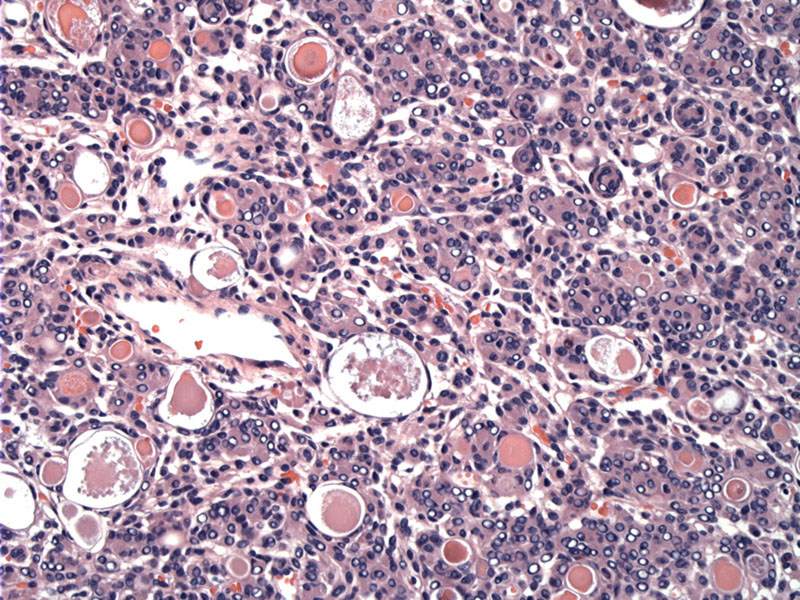

Cystic spaces contain eosinophilic material which sometimes appears concrete-like. These deep pink, well-defined, round secretions with a clear rim simulate a psammoma bodies, hence its designation as a pseudopsammona bodies.
There are also some amorphous, perhaps calcific deposits -- some appear to involve the pseudopsammoma bodies. It is not clear to the authors what this material is, exactly.
Cleared-out nuclei are present. The pink round secretions are PAS positive.
A smear shows intact whorls seen in more conventional variants.
EMA is focally positive in the neoplastic cells.
CD99 is diffusely positive.
While secretory meningiomas are relatively benign slow-growing neoplasms (WHO Grade I), this particular variant is prone to peritumoral edema which leads to severe neurological complications.
For example, in a review of 44 secretory meningiomas, Regelsberger and colleagues found that 18 (41%) of cases had severe peritumoral edema, and in 15 patients, edema persisted and even worsened postoperatively; 6 patients had midline shifts that required ventilatory support and intracranial pressure monitoring. Furthermore, Regelsberger found significant associations between the number of pseudopsammoma bodies and the size of the edema. The number of CEA and CK positive neoplastic cells also correlated with the severity of edema. Ki-67 was not associated with edema or tumor recurrence (Regelsberger).
Buhl and colleagues had similar conclusions in 11 secretory meningiomas in which all patients were females. Brain edema was present in 82% of cases. They also found pseudopsammoma bodies were present in all tumors, and tumor cells characteristically stained for CEA and EMA. They did not correlate the number of pseudopsammoma bodies and CEA/EMA positive cells with extent of edema, however.
Histologically, this variant is characterized by glandular lumina containing PAS-positive eosinophilic material called pseudopsammoma bodies.
• Meninges : Meningioma, Transitional Variant
• Meninges : Meningioma, Fibrous Variant
• Meninges : Meningioma, Psammomatous Variant
• Meninges : Meningioma, Chordoid Variant
• Meninges : Meningioma, Microcystic Variant
• Meninges : Meningioma, Clear Cell Variant
• Meninges : Meningioma, Angiomatous Variant
• Meninges : Meningioma, Meningotheliomatous (Syncytial) Variant
Buhl R, Hugo HH, Mihajlovic Z, Mehdorn HM. Secretory meningiomas: clinical and immunohistochemical observations. Neurosurgery. 2001 Feb;48(2):297-301; discussion 301-2.
Regelsberger J, Hagel C, Emami P et al. Secretory meningiomas: a benign subgroup causing life-threatening complications. Neuro Oncol. 2009 Dec;11(6):819-24.